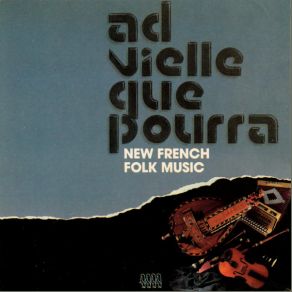New French Folk Music
Download links and information about New French Folk Music by Ad Vielle Que Pourra. This album was released in 1989 and it belongs to New Age, World Music, Pop, Songwriter/Lyricist, Celtic genres. It contains 13 tracks with total duration of 52:08 minutes.

|
|
|---|---|
| Artist: | Ad Vielle Que Pourra |
| Release date: | 1989 |
| Genre: | New Age, World Music, Pop, Songwriter/Lyricist, Celtic |
| Tracks: | 13 |
| Duration: | 52:08 |
| Buy it NOW at: | |
| Buy on iTunes $9.99 | |
Tracks
[Edit]| No. | Title | Length |
|---|---|---|
| 1. | Schottische du stockfish | 4:21 |
| 2. | Malloz ar barz koz o vervel | 3:11 |
| 3. | Chupad melen / Hanterdro tid' poc'h | 3:16 |
| 4. | L'agacante / Valse du milieu / Valse du faucigny | 5:03 |
| 5. | La pucelle d'Ussel | 2:42 |
| 6. | Les filles de France | 5:57 |
| 7. | Suite de gavottes evit Leroux | 4:37 |
| 8. | Bourrées dans le jardin | 5:37 |
| 9. | Polkas ratées | 3:13 |
| 10. | Valse des coquelicots / Java niaise | 1:44 |
| 11. | Fillettes des campagnes | 2:36 |
| 12. | An dro pitaouer / An dro evit jakeza | 5:22 |
| 13. | La malfaissante | 4:29 |
Details
[Edit]New French Folk Music was the first album by this group of five Belgian, Breton, and French-Canadian musicians who met in Quebec in 1985. Inspired by a love of Breton (French Celtic) and other rural French music, they came together to play in that same spirit. All their tunes are originals but most of their instruments are traditional, like the hurdy-gurdy, the bombarde (an ancestor of the oboe that sounds like a wooden trumpet), and the accordion. One enjoyable element on this album that is absent on later ones is occasional use of percussion: it's not listed in the notes, but it sounds like either foot percussion or something like clave sticks. Most of the texts are traditionals, but some are not, as in "Bourrée Dans le Jardin." The title is a pun. A "bourrée" is a kind of folk dance (also used in classical music) but it also refers to a drunk. So the title means both "a dance in the garden" and "a drunk in the garden." This kind of wordplay, sometimes carried on across two or three languages, is typical of Ad Vielle Que Pourra, whose own name is a pun on the French expression for "come what may," with the French name for the hurdy-gurdy slyly insinuated. The number itself is a riot of delightful dance melody and droll singing. More here than on later albums, an interesting quality evocative of medieval music emerges on some of the instrumental tracks. The number "An Dro Pitaouer/An Dro Evit Jakeza" begins very much in this vein, although it sounds a bit like an American hoe-down by the end. The antique quality is not surprising, though, given that folk music is closer to early music than other forms, and that three of the five members of Ad Vielle have studied medieval or Renaissance music. Compared to the group's later efforts, the tunes on New French Folk Music are simpler, the recording is not as rich, and the singing is not as seasoned. Still, all the elements that made Ad Vielle such a treat are present and no real fan of their quirky sound should be without this album.